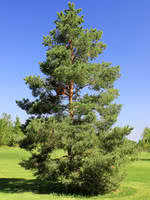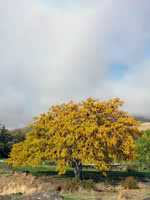Mon-Fri 9am - 5pm Mountain time
Scots Pine (Scotch Pine) vs Thornless Honeylocust
Pinus sylvestris
Gleditsia triacanthos inermis
Scots Pine is a hardy, adaptable evergreen. This large tree has an oval crown and distinctively orange bark when mature. Scots Pine prefers dry to average moisture levels with very well-drained soil.
It is the most common pine tree used in shelterbelts and windbreaks. Scots Pine is also occasionally used as a Christmas tree variety.
Thornless Honey Locust makes an excellent shade tree with its lacy foliage and dappled shade. The leaves are honey-yellow, light and airy, providing interesting color and texture to your landscape. This variety is thornless, and the seeds and pods provide food for wildlife such as deer and squirrels.
The Thornless Honey Locust is tolerant of drought, various soil conditions, and even road salt.
Scots Pine (Scotch Pine) Quick Facts
Thornless Honeylocust Quick Facts
In row spacing: 3 - 4 m (10 - 12 ft)

